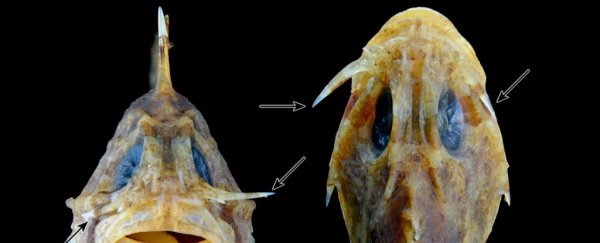Stonefish are already pretty badass – they're the most venomous type of fish we know of, and have a number of sharp fin spines on their body that can unsheathe and attack you at a moment's notice.
But stonefishes have just gone up a level, with scientists discovering the group also has what is basically a switchblade-like bone located under each eye socket.
The researchers have called the switchblade bone a "lachrymal saber", and the terrifying skeletal addition appears to be unique to the stonefish.
"I don't know why this hasn't been discovered before," said William Leo Smith, from the University of Kansas.
"It's probably because there are just one or two people that ever worked on this group."
Stonefish also have a number of muscles and bones, including the circumorbitals, and maxilla and adductor mandibulae, that they've repurposed to control this dangerous system.
"This whole group of fishes is called the 'mail cheek fishes' or Scorpaeniformes, where the bones under the eye attach to the gill skeleton," said Smith.
"Because all these muscles are attached to the gill skeleton, it allows for all this force which causes the lachrymal saber to deploy."
When it does deploy, it kind of looks like a deadly moustache, with the bones going outwards horizontally, rather than straight.
When it's 'sheathed', the bone moves back down, and sits comfortably against the stonefishes face.
Scientists already knew that these lachrymal sabers existed to some extent – they are on the outside of the face after all - instead what Smith noticed was the large number of modifications to allow these fish to lock out these appendages.
Smith himself discovered the weird mechanisms of the sabers 15 years ago while dissecting a waspfish (Paracentropogon longispinis).
Since then it's been a long road of confirming how the mechanism worked, and finding all the potential fish that have this feature.
Thanks to that time spent, this latest study not only shows off the sabers, but also shows the evolution of the defence mechanism, and updates the definition of a stonefish to include a number of other fish types.
Smith and the University of Kansas team genetically analysed 113 morphological and 5,280 molecular characteristics for 63 species of stonefish.
"Every species of stonefish (Synanceiidae) that I have examined has this feature [the lachrymal sabers], and it defines this group just as a mammal is defined by mammary glands," Smith clarified in an email with ScienceAlert.
"The paper dramatically revised the definition of a stonefish and made it a much larger group of organisms … The group now includes velvetfishes, waspfishes, prowfishes, stingfishes, etc."
Who knew that a deadly moustache could be such a game changer?
The research has been published in Copeia.
